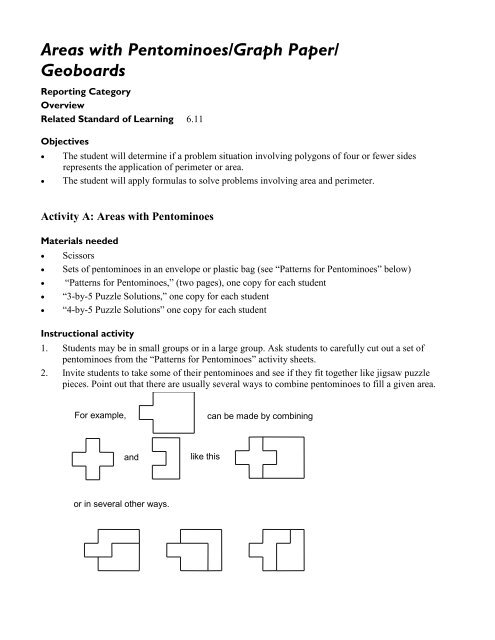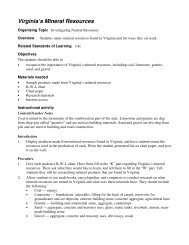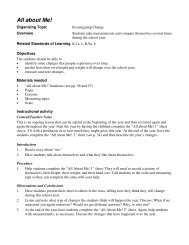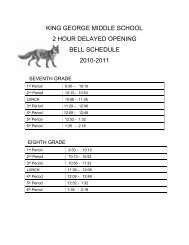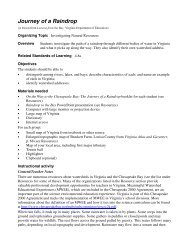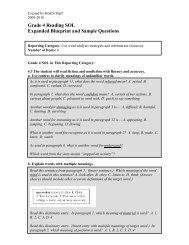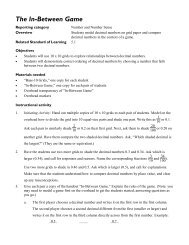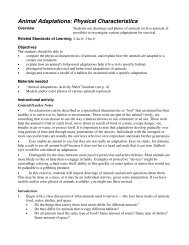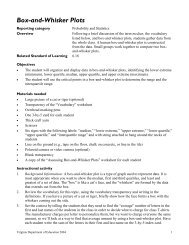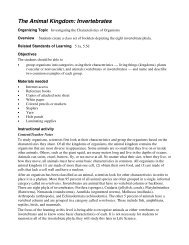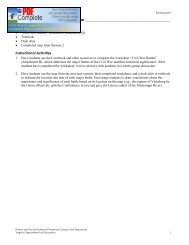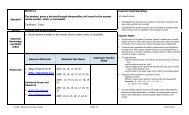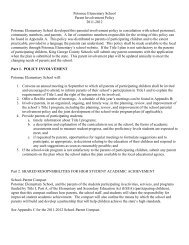Areas with Pentominoes/Graph Paper
Areas with Pentominoes/Graph Paper
Areas with Pentominoes/Graph Paper
You also want an ePaper? Increase the reach of your titles
YUMPU automatically turns print PDFs into web optimized ePapers that Google loves.
<strong>Areas</strong> <strong>with</strong> <strong>Pentominoes</strong>/<strong>Graph</strong> <strong>Paper</strong>/<br />
Geoboards<br />
Reporting Category<br />
Overview<br />
Related Standard of Learning 6.11<br />
Objectives<br />
<br />
<br />
The student will determine if a problem situation involving polygons of four or fewer sides<br />
represents the application of perimeter or area.<br />
The student will apply formulas to solve problems involving area and perimeter.<br />
Activity A: <strong>Areas</strong> <strong>with</strong> <strong>Pentominoes</strong><br />
Materials needed<br />
<br />
<br />
<br />
<br />
<br />
Scissors<br />
Sets of pentominoes in an envelope or plastic bag (see “Patterns for <strong>Pentominoes</strong>” below)<br />
“Patterns for <strong>Pentominoes</strong>,” (two pages), one copy for each student<br />
“3-by-5 Puzzle Solutions,” one copy for each student<br />
“4-by-5 Puzzle Solutions” one copy for each student<br />
Instructional activity<br />
1. Students may be in small groups or in a large group. Ask students to carefully cut out a set of<br />
pentominoes from the “Patterns for <strong>Pentominoes</strong>” activity sheets.<br />
2. Invite students to take some of their pentominoes and see if they fit together like jigsaw puzzle<br />
pieces. Point out that there are usually several ways to combine pentominoes to fill a given area.<br />
For example,<br />
can be made by combining<br />
and<br />
like this<br />
or in several other ways.
3. Have students fill in the 3-by-5 and 4-by-5 areas <strong>with</strong> pentominoes. Ask them to keep a record of<br />
their work on a separate piece of graph paper. Have them compare their results <strong>with</strong> the 3-by-5 and<br />
4-by-5 Puzzle Solutions.<br />
4. Ask students how many square units there are in each pentomino. Ask them to find the pentomino<br />
<strong>with</strong> the largest perimeter and the pentomino <strong>with</strong> the smallest perimeter. Discuss how shapes <strong>with</strong><br />
the same area can have different perimeters.<br />
Sample assessment<br />
<br />
Ask students how many square units there are in all 12 pentominoes combined. (60) Have them<br />
design a symmetrical shape <strong>with</strong> an area equal to 60 square units and then see if it can be completely<br />
filled in <strong>with</strong> all twelve pentominoes.<br />
Activity B: The Perimeter Is 24 Inches. What Is the Area?<br />
Materials needed<br />
<br />
<br />
<br />
<br />
24-inch paper strip (collar)<br />
38 1-inch cubes<br />
1-inch block graph paper<br />
1<br />
2<br />
-inch block graph paper<br />
Instructional activity<br />
1. Organize the students into teams of two or three.<br />
2. Ask the teams to find out how many different rectangular arrays they can make that have a perimeter<br />
of 24 inches. Have them make the arrays <strong>with</strong> the cubes and have them check the perimeter <strong>with</strong> a<br />
24-inch collar. What is the area of each array?<br />
3. Once they find a rectangular array, have them draw its representation on the graph paper and write<br />
the perimeter and area for each array.<br />
Activity C: Change The Area<br />
Materials needed<br />
<br />
<br />
Square geoboards,<br />
Rubber bands<br />
Instructional activity<br />
1. Organize students into small groups.<br />
2. Have students copy this figure on the geoboard and onto dot paper,<br />
labeling its area and perimeter.
3. Have students change the figure to make another shape that has the same area and a larger perimeter,<br />
recording it on dot paper <strong>with</strong> its area and perimeter.<br />
4. Have the participants change the figure to make another shape that has the same area and a smaller<br />
perimeter, recording it on dot paper <strong>with</strong> its area and perimeter.<br />
Sample assessment<br />
<br />
<br />
Have the students make three more shapes that have different perimeters but the same area,<br />
recording them on dot paper.<br />
Have them record their observations in their math journal.<br />
Activity D: <strong>Areas</strong> of Polygons on the Geoboard<br />
Materials needed<br />
<br />
Square geoboard and rubber bands, one set for each student<br />
Instructional activity<br />
1. Have students construct this rectangle on their geoboards and find its area. They should record it and<br />
its area on the geoboard dot paper.<br />
2. Have students construct this right triangle and find its area by first counting squares in the<br />
corresponding rectangle. Record.
3. Have students construct this figure and find its area by counting squares.<br />
4. Have students form a 2 by 4 rectangle and construct this figure <strong>with</strong>in it. They should then find its<br />
area from the area of the rectangle and record.<br />
5. Have students construct this square on their geoboards, find its area, and record.<br />
6. The students should next construct this square on their geoboards, find its area, and record.
7. Have the participants construct this triangle, find its area, and record.<br />
Follow-up/extension<br />
<br />
Have students find the area of these triangles using their geoboards. Discuss what they discovered.<br />
<br />
Next have students construct this triangle on their geoboard and find its area. Hint: They should start<br />
<strong>with</strong> the area of the rectangle enclosing it.<br />
<br />
The area of the previous triangle was 4 1 square units. Have students construct as many other<br />
2<br />
triangles as they can <strong>with</strong> the same area, but <strong>with</strong> different shapes. They should copy each one on<br />
their geoboard dot paper.<br />
Homework<br />
<br />
Have each student make a complicated polygon on his/her geoboard and find its area. Then they<br />
should give it to another student to find the area.
One-Inch <strong>Graph</strong> <strong>Paper</strong>
One-Half-Inch <strong>Graph</strong> <strong>Paper</strong>
Geoboard Dot <strong>Paper</strong>
Patterns for <strong>Pentominoes</strong>
Patterns for <strong>Pentominoes</strong>
3-by-5 Puzzle Solutions
4-by-5 Puzzle Solutions


